Load Forecast of Electric Vehicle Charging Station Considering Multi-Source Information and User Decision Modification
Abstract
:1. Introduction
2. Framework of EVCS Load Forecasting Model Based on Multi-Source Information and Prospect Theory
2.1. Establishment of Multi-Source Information Interaction System
2.2. Framework of EVCS Load Forecasting Model
3. EV Owner Decision Model Based on Prospect Theory
3.1. Prospect Theory Decision Model
3.2. Determination of TCVs in Prospect Theory
4. Case Study and Discussion
4.1. Model Construction
4.2. Selection of Experiment Times and Accuracy Measure
4.3. Validity Analysis of Prospect Theory Decision Making
4.4. Spatial and Temporal Distribution Analysis of Charging Load under Different EV Penetration Rate
5. Conclusions
- (1)
- The load forecast of EV charging stations considering multi-source information and user decision modification, can avoid inaccurate load forecasts caused by long queues at charging stations. It can also avoid the behavior of the car owner going to the charging station with a higher electricity price when the charging station is relatively idle, which is more in line with the actual decisions of car owners.
- (2)
- The method proposed in this paper can balance the load of each charging station. On the premise that private cars are charged in residential areas, the ratio between the number of chargers and the number of EVs can be further discussed to avoid excessive vehicle aggregation or a large number of idle chargers.
- (3)
- However, there are still some shortcomings in this paper. For example, the proportion of each influencing factor and reference point in different actual prospect theory decision-making situations of EV users needs to be a personalized adjustment, which will be considered in the following research.
Author Contributions
Funding
Institutional Review Board Statement
Informed Consent Statement
Data Availability Statement
Conflicts of Interest
Appendix A
| Departure \Destination | Residence | Work | Business | Special |
|---|---|---|---|---|
| Residence | 0.2 | 0.55 | 0.2 | 0.05 |
| Work | 0.2 | 0.6 | 0.15 | 0.05 |
| Business | 0.2 | 0.4 | 0.4 | 0 |
| Special | 0.2 | 0.8 | 0 | 0 |
| Departure \Destination | Residence | Work | Business | Special |
|---|---|---|---|---|
| Residence | 0.5 | 0.1 | 0.4 | 0 |
| Work | 0.6 | 0.1 | 0.3 | 0 |
| Business | 0.6 | 0.1 | 0.3 | 0 |
| Special | 0.2 | 0.8 | 0 | 0 |
| Departure \Destination | Residence | Work | Business |
|---|---|---|---|
| Residence | 0.8 | 0.1 | 0.1 |
| Work | 0.8 | 0.1 | 0.1 |
| Business | 0.7 | 0.1 | 0.2 |
| Area \Time(min) | 7:00~17:00 | 17:00~22:00 | 22:00~7:00 (+1) |
|---|---|---|---|
| Residence | 1 | 1 | 6 |
| Work | 2 | 1 | 5 |
| Business | 4 | 2 | 4 |
| Special | 3 | 0 | 0 |
| TOU price level | Road node where the EVCS is located |
|---|---|
| Level 1 | 18, 21, 22, 31, 43 |
| Level 2 | 9, 17, 47 |
| Level 3 | 5, 7, 29, 32 |
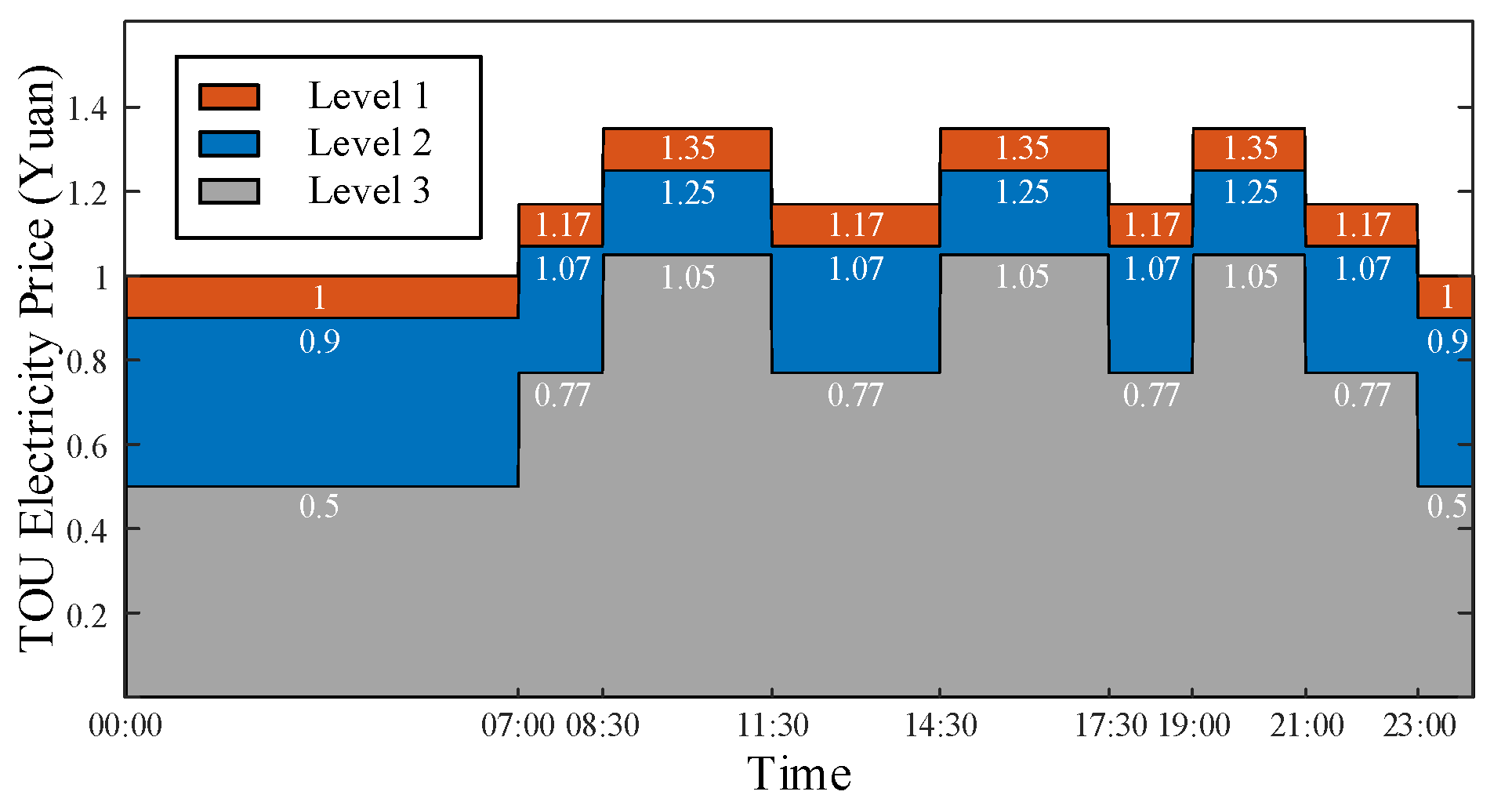
References
- Bjerkan, K.Y.; Norbech, T.E.; Nordtomme, M.E. Incentives for Promoting Battery Electric Vehicle (BEV) Adoption in Norway. Transp. Res. Part D 2016, 43, 169–180. [Google Scholar] [CrossRef]
- Ahmadian, A.; Mohammadi-Ivatloo, B.; Elkamel, A. A Review on Plug-in Electric Vehicles: Introduction, Current Status, and Load Modeling Techniques. J. Mod. Power Syst. Clean Energy 2020, 8, 412–425. [Google Scholar] [CrossRef]
- Huang, Z.; Fang, B.; Deng, J. Multi-objective Optimization Strategy for Distribution Network Considering V2G-enabled Electric Vehicles in Building Integrated Energy System. Prot. Control. Mod. Power Syst. 2020, 5, 7. [Google Scholar] [CrossRef]
- Raoofat, M.; Saad, M.; Lefebvre, S.; Asber, D.; Mehrjedri, H. Wind Power Smoothing Using Demand Response of Electric Vehicles. Int. J. Electr. Power Energy Syst. 2018, 99, 164–174. [Google Scholar] [CrossRef]
- Yang, T.; Xu, X.; Guo, Q.; Zhang, L.; Sun, H. EV Charging Behaviour Analysis and Modelling Based on Mobile Crowdsensing Data. IET Gener. Transm. Distrib. 2017, 11, 1683–1691. [Google Scholar] [CrossRef]
- Chis, A.; Lunden, J.; Koivunen, V. Reinforcement Learning-Based Plug-in Electric Vehicle Charging with Forecasted Price. IEEE Trans. Veh. Technol. 2017, 66, 3674–3684. [Google Scholar] [CrossRef]
- Buzna, L.; de Falco, P.; Ferruzzi, G.; Khormali, S.; Proto, D.; Refa, N.; Straka, M.; van der Poel, G. An Ensemble Methodology for Hierarchical Probabilistic Electric Vehicle Load Forecasting at Regular Charging Stations. Appl. Energy 2021, 283, 116337. [Google Scholar] [CrossRef]
- Pertl, M.; Carducci, F.; Tabone, M.; Marinelli, M.; Kiliccote, S.; Kara, E.C. An Equivalent Time-Variant Storage Model to Harness EV Flexibility: Forecast and Aggregation. IEEE Trans. Ind. Inform. 2019, 15, 1899–1910. [Google Scholar] [CrossRef]
- Gilanifar, M.; Parvania, M. Clustered Multi-node Learning of Electric Vehicle Charging Flexibility. Appl. Energy 2021, 282, 116125. [Google Scholar] [CrossRef]
- Jahangir, H.; Gougheri, S.S.; Vatandoust, B.; Golkar, M.A.; Ahmadian, A.; Hajizadeh, A. Plug-in Electric Vehicle Behavior Modeling in Energy Market: A Novel Deep Learning-Based Approach with Clustering Technique. IEEE Trans. Smart Grid 2020, 11, 4738–4748. [Google Scholar] [CrossRef]
- Dabbaghjamanesh, M.; Moeini, A.; Kavousi-Fard, A. Reinforcement Learning-based Load Forecasting of Electric Vehicle Charging Station Using Q-Learning Technique. IEEE Trans. Ind. Inform. 2021, 17, 4229–4237. [Google Scholar] [CrossRef]
- Dai, Q.; Cai, T.; Duan, S.; Zhao, F. Stochastic Modeling and Forecasting of Load Demand for Electric Bus Battery-Swap Station. IEEE Trans. Power Deliv. 2014, 29, 1909–1917. [Google Scholar] [CrossRef]
- Moon, H.; Park, S.Y.; Jeong, C.; Lee, J. Forecasting Electricity Demand of Electric Vehicles by Analyzing Consumers’ Charging Patterns. Transp. Res. Part D 2018, 62, 64–79. [Google Scholar] [CrossRef]
- Sadeghianpourhamami, N.; Refa, N.; Strobbe, M.; Develder, C. Quantitive Analysis of Electric Vehicle Flexibility: A Data-driven Approach. Int. J. Electr. Power Energy Syst. 2018, 95, 451–462. [Google Scholar] [CrossRef]
- Savari, G.F.; Krishnasamy, V.; Sathik, J.; Ali, Z.M.; Aleem, S.H.E.A. Internet of Things Based Real-time Electric Vehicle Load Forecasting and Charging Station Recommendation. ISA Trans. 2020, 97, 431–447. [Google Scholar] [CrossRef] [PubMed]
- Shepero, M.; Munkhammar, J. Spatial Markov Chain Model for Electric Vehicle Charging in Cities Using Geographical Information System (GIS) Data. Appl. Energy 2018, 231, 1089–1099. [Google Scholar] [CrossRef]
- Iwafune, Y.; Ogimoto, K.; Kobayashi, Y.; Murai, K. Driving Simulator for Electric Vehicles Using the Markov Chain Monte Carlo Method and Evaluation of the Demand Response Effect in Ewsidential Houses. IEEE Access 2020, 8, 47654–47663. [Google Scholar] [CrossRef]
- Dabbaghjamanesh, M.; Kavousi-Fard, A.; Zhang, J. Stochastic Modeling and Integration of Plug-In Hybrid Electric Vehicles in Reconfigurable Microgrids with Deep Learning-Based Forecasting. IEEE Trans. Intell. Transp. Syst. 2021, 22, 4394–4403. [Google Scholar] [CrossRef]
- Islam, M.S.; Mithulananthan, N.; Hung, D.Q. A Day-Ahead Forecasting Model for Probabilistic EV Charging Loads at Business Premises. IEEE Trans. Sustain. Energy 2018, 9, 741–753. [Google Scholar] [CrossRef]
- Liu, Q.; Kamoto, K.M.; Liu, X.; Zhang, Y.; Yang, Z.; Khosravi, M.R.; Xu, Y.; Qi, L. A Sensory Similarities Approach to Load Disaggregation of Charging Stations in Internet Electric Vehicles. IEEE Sens. J. 2021, 21, 15895–15903. [Google Scholar] [CrossRef]
- Zhang, X.; Fan, Z. Method for Risky Hybrid Multiple Attribute Decision Making Based on Prospect Theory. J. Syst. Eng. 2012, 27, 772–780. [Google Scholar]
- Gao, K.; Yang, Y.; Qu, X. Diverging Effects of Subjective Prospect Values of Uncertain Time and Money. Commun. Transp. Res. 2021, 1, 100007. [Google Scholar] [CrossRef]
- Chen, L.; Zhang, Y.; Antonio, F. Charging Load Forecasting of Electric Vehicles Based on Multi-source Information Fusion and its Influence on Distribution Network. Electr. Power Autom. Equip. 2018, 38, 1–10. [Google Scholar]
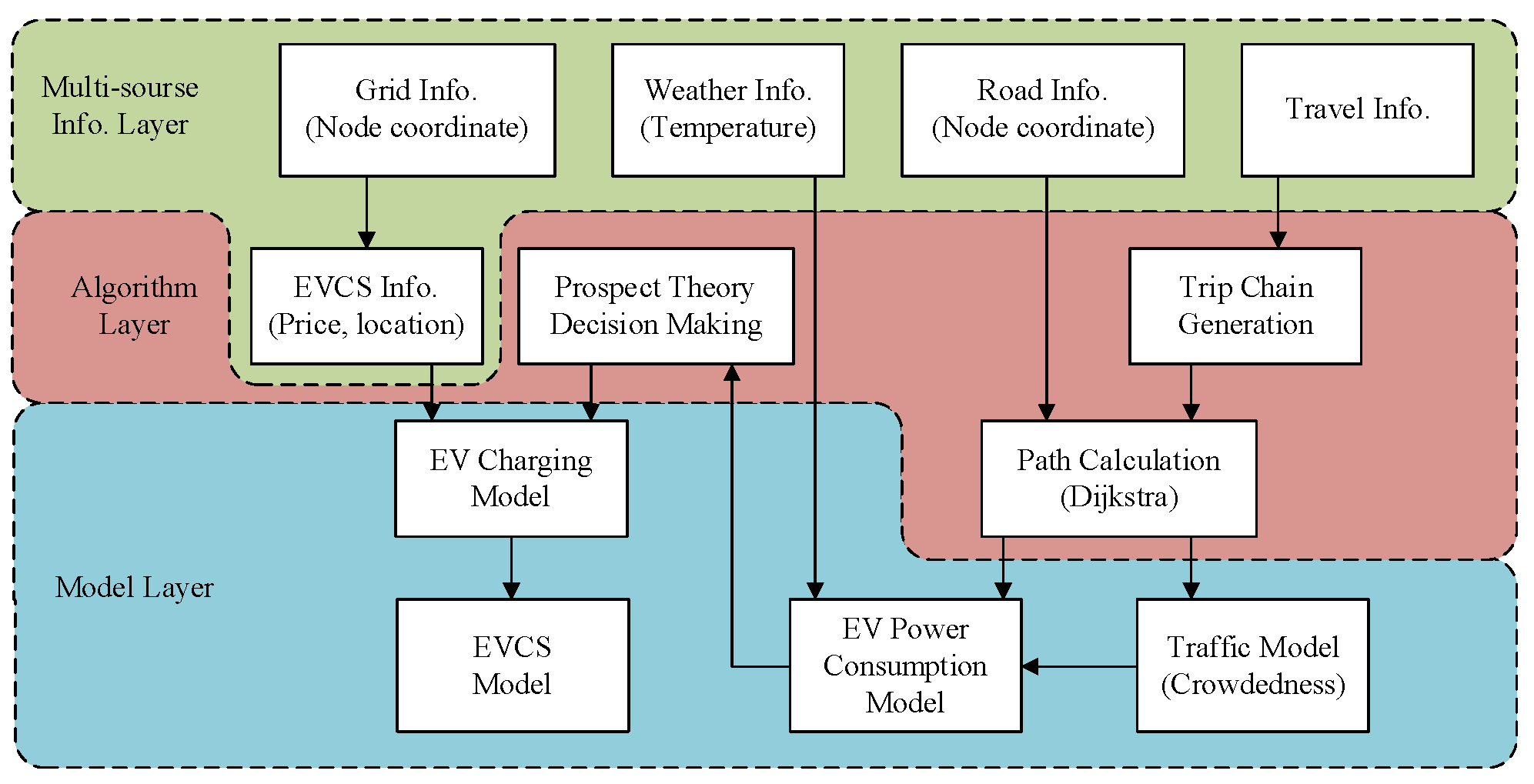
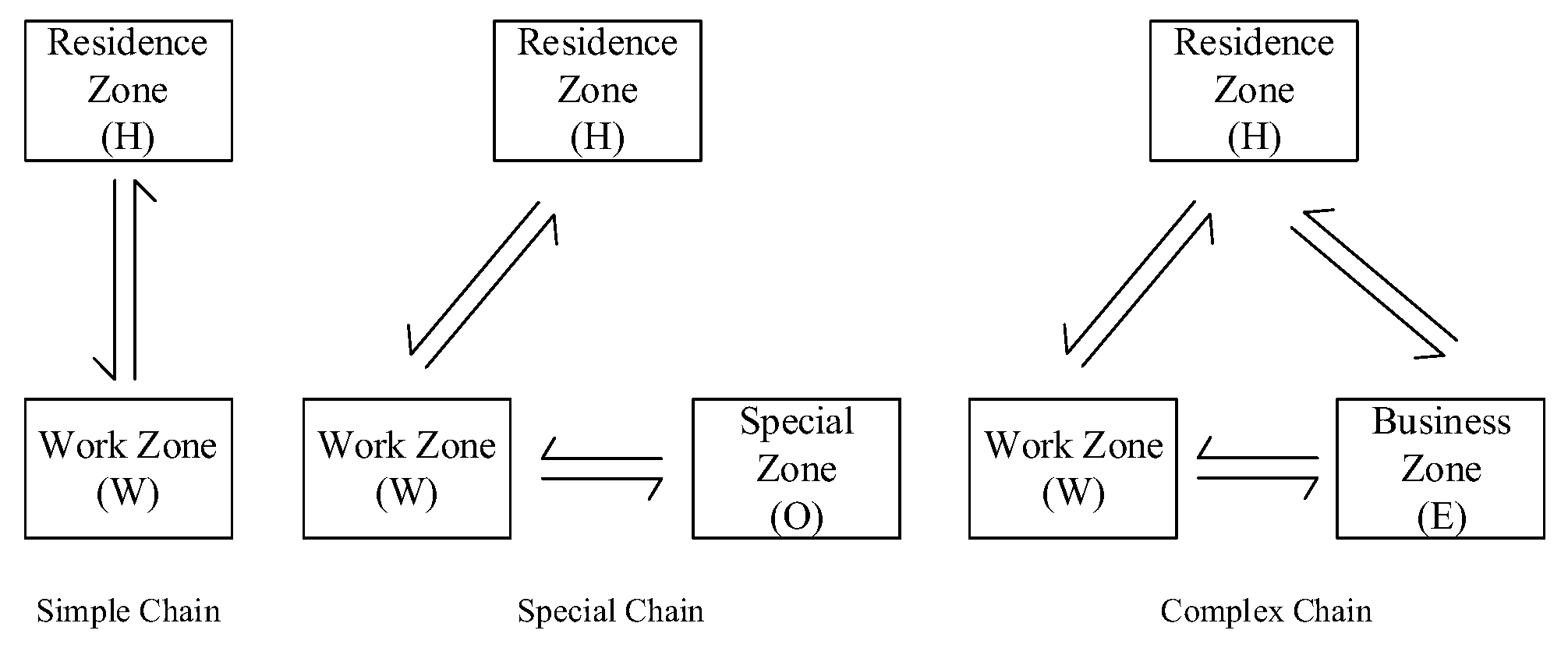



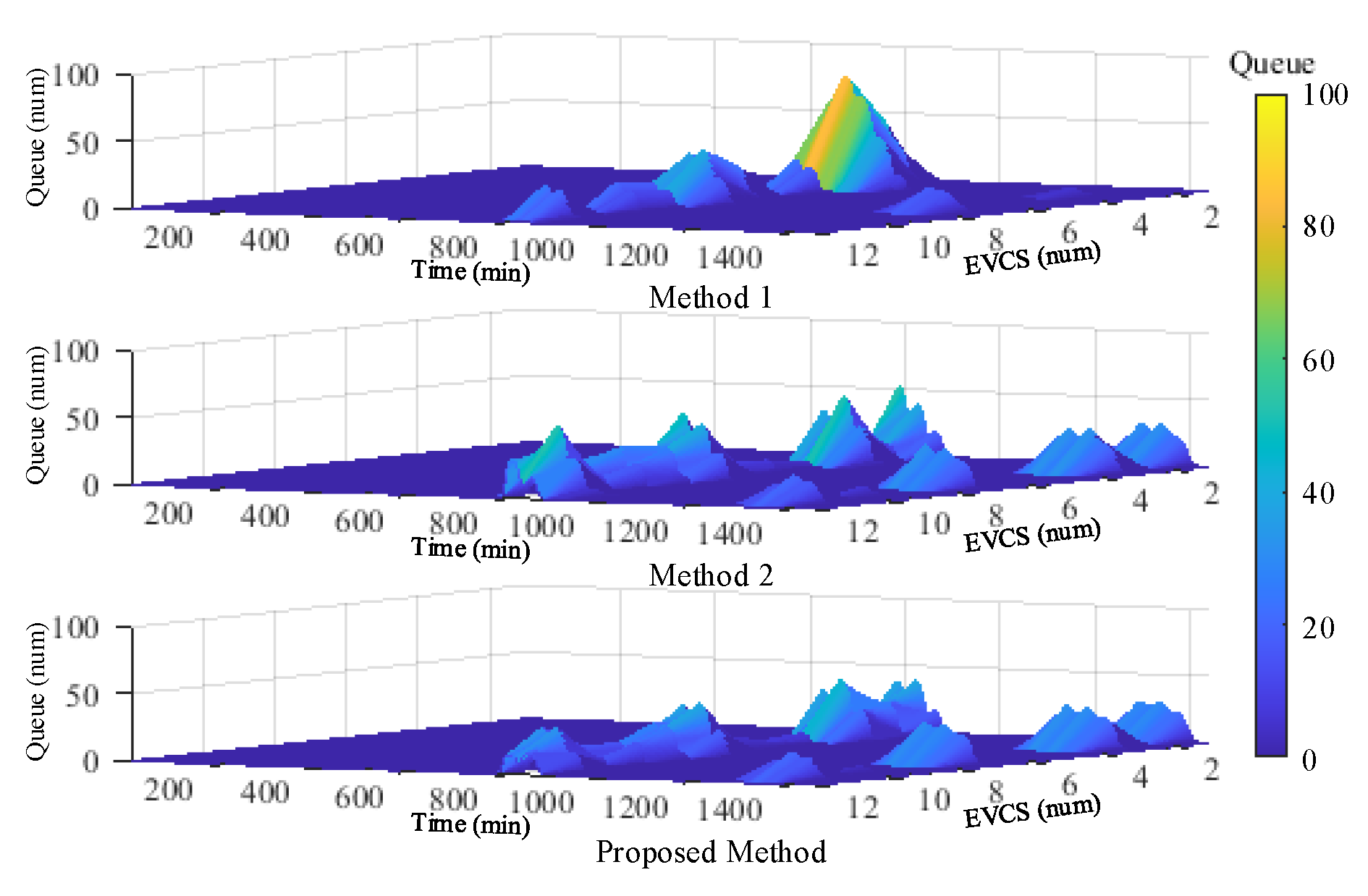

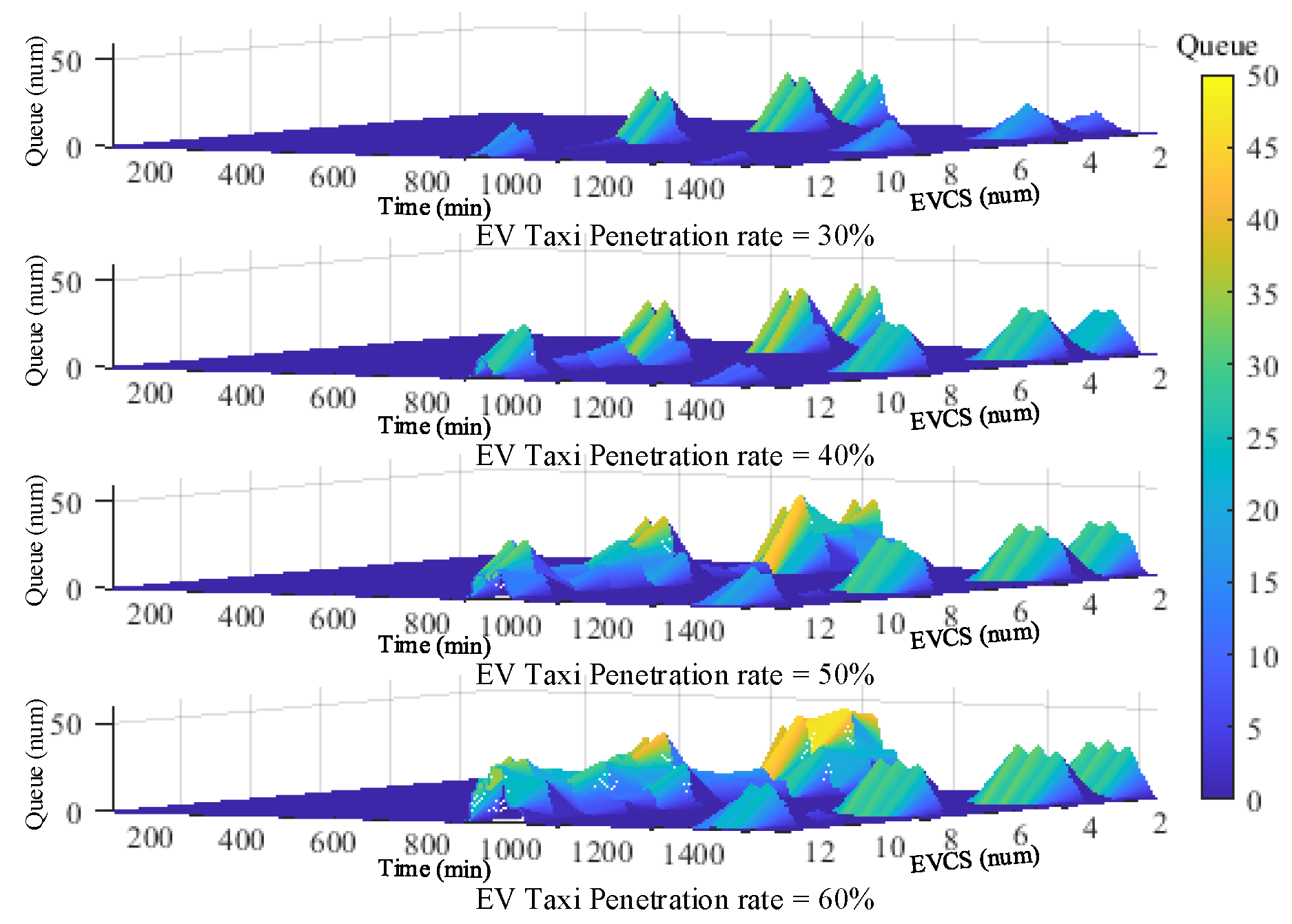
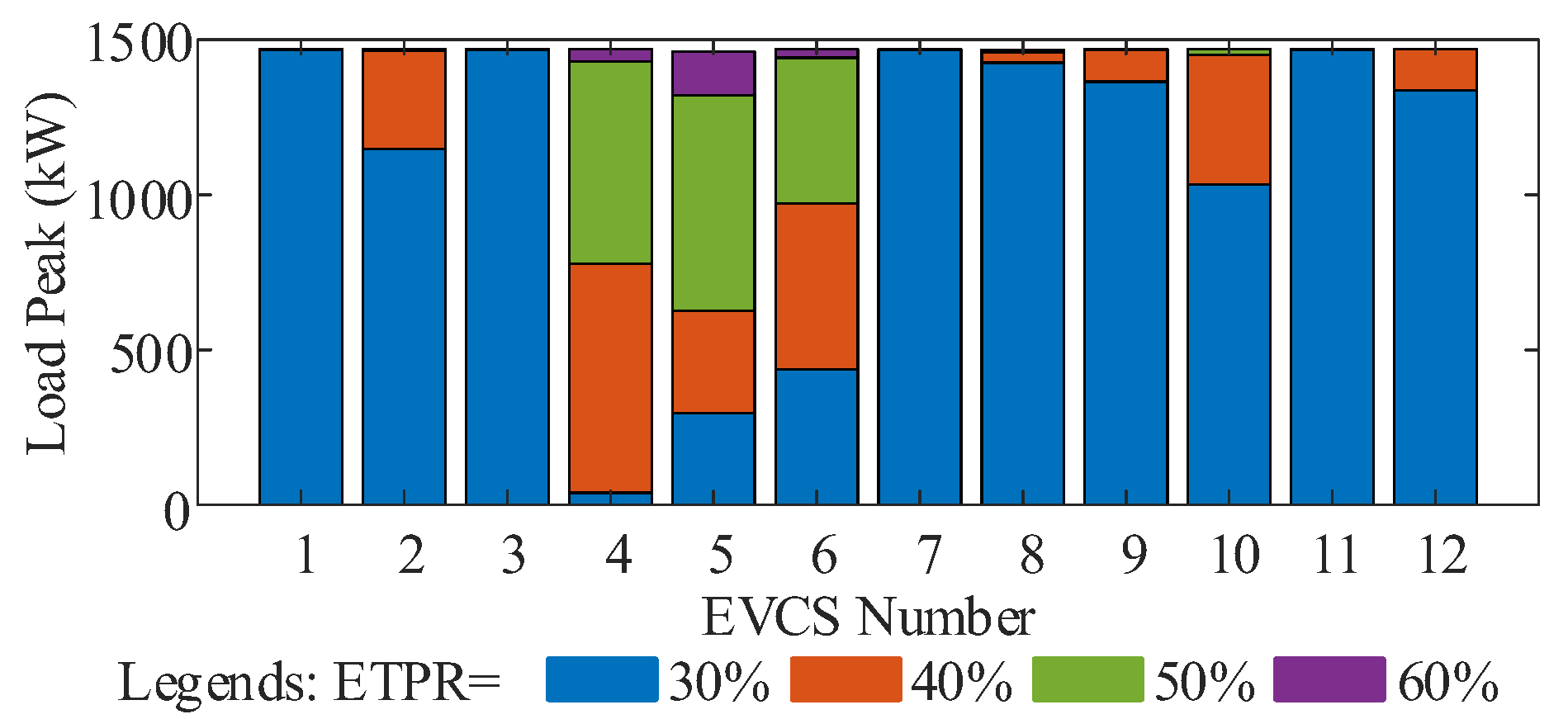

| Departure \Destination | Residence | Work | Business |
|---|---|---|---|
| Residence | 0.8 | 0.1 | 0.1 |
| Work | 0.8 | 0.1 | 0.1 |
| Business | 0.7 | 0.1 | 0.2 |
| Array | Payment | Time Cost | Route |
|---|---|---|---|
| Payment | 1 | 1/2 | 2 |
| Time Cost | 2 | 1 | 3 |
| Route | 1/2 | 1/3 | 1 |
| I in (17) | 1st Peak Ave. Accuracy(%) | 2nd Peak Ave. Accuracy(%) | Operation Time (min) |
|---|---|---|---|
| 500 | 73.00 | 60.89 | 20 |
| 1500 | 77.30 | 68.85 | 58 |
| 3000 | 77.51 | 71.19 | 110 |
| 5000 | 75.77 | 75.51 | 189 |
| 10,000 | 80.63 | 76.85 | 376 |
| 15,000 | 79.00 | 78.10 | 625 |
| Methods | 1st Peak Queue Value | 1st Queue Finish Time | Idle EVCS Time Difference |
|---|---|---|---|
| Method 1 | 84 | 16:05 | 135 min |
| Method 2 | 52 | 15:53 | 116 min |
| Proposed | 44 | 15:03 | 42 min |
| EV Taxi Penetration | 1st Peak Queue Value | 1st Queue Finish Time | Idle EVCS Time Difference |
|---|---|---|---|
| 30% | 32 | 14:41 | 63 min |
| 40% | 36 | 14:45 | 32 min |
| 50% | 44 | 15:03 | 33 min |
| 60% | 47 | 16:14 | 90 min |
Publisher’s Note: MDPI stays neutral with regard to jurisdictional claims in published maps and institutional affiliations. |
© 2022 by the authors. Licensee MDPI, Basel, Switzerland. This article is an open access article distributed under the terms and conditions of the Creative Commons Attribution (CC BY) license (https://creativecommons.org/licenses/by/4.0/).
Share and Cite
Zhuang, Z.; Zheng, X.; Chen, Z.; Jin, T.; Li, Z. Load Forecast of Electric Vehicle Charging Station Considering Multi-Source Information and User Decision Modification. Energies 2022, 15, 7021. https://doi.org/10.3390/en15197021
Zhuang Z, Zheng X, Chen Z, Jin T, Li Z. Load Forecast of Electric Vehicle Charging Station Considering Multi-Source Information and User Decision Modification. Energies. 2022; 15(19):7021. https://doi.org/10.3390/en15197021
Chicago/Turabian StyleZhuang, Zhiyuan, Xidong Zheng, Zixing Chen, Tao Jin, and Zengqin Li. 2022. "Load Forecast of Electric Vehicle Charging Station Considering Multi-Source Information and User Decision Modification" Energies 15, no. 19: 7021. https://doi.org/10.3390/en15197021
APA StyleZhuang, Z., Zheng, X., Chen, Z., Jin, T., & Li, Z. (2022). Load Forecast of Electric Vehicle Charging Station Considering Multi-Source Information and User Decision Modification. Energies, 15(19), 7021. https://doi.org/10.3390/en15197021





